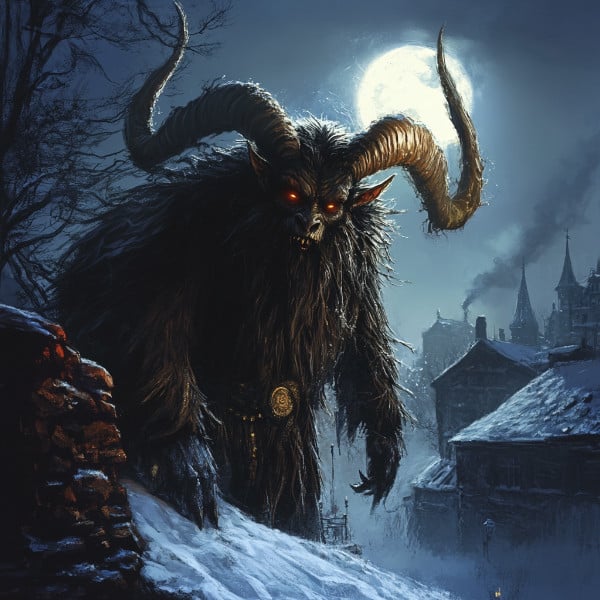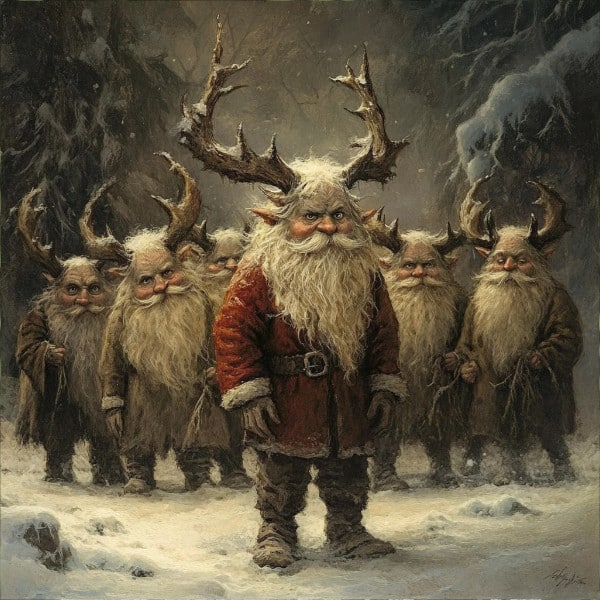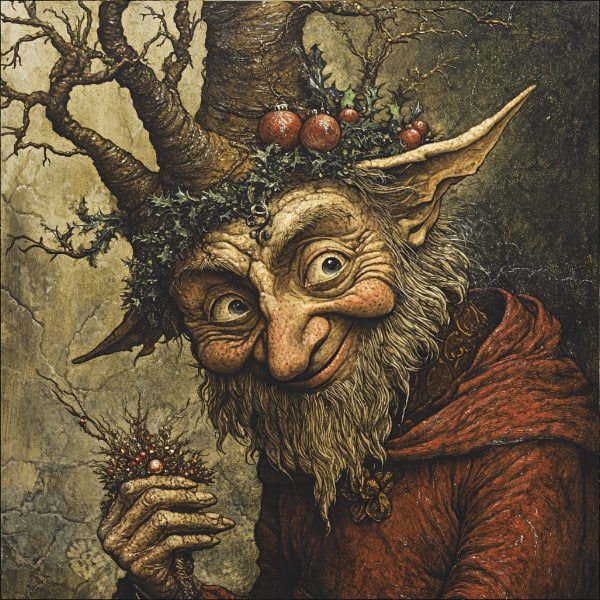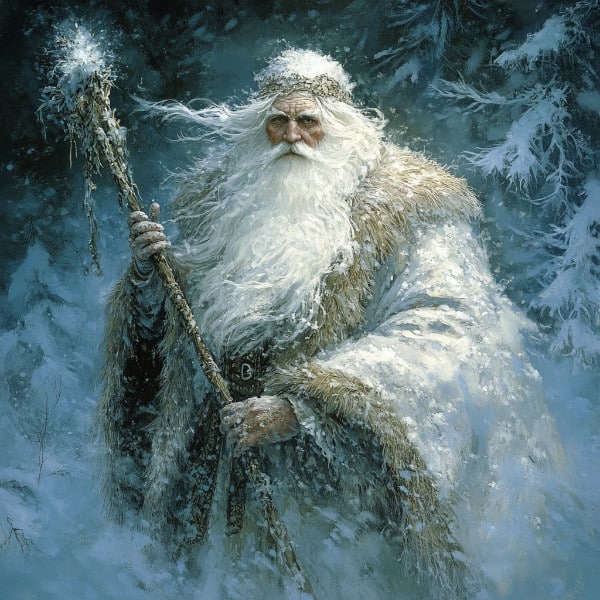
While we all know and love the legend of Santa Klaus and his yearly journey to bring joy to children all across the world. But there are a whole host of other legendary beings that haunt the shadows of the Yule season.
Here are twelve of the creepiest entities that you may experience around the winter solstice and Christmas.
1. Krampus (Central Europe)

Krampus is a fearsome figure from Alpine folklore, serving as the dark counterpart to St. Nicholas. This horned, devilish creature appears during Christmastime, wielding chains, bells, and birch branches to punish misbehaving children. Unlike St. Nicholas, who rewards the good, Krampus drags the naughty away, either to his lair or to face a terrifying fate.
In some traditions, Krampusnacht, or “Krampus Night,” takes place on December 5th, when costumed revelers parade through towns, scaring onlookers and celebrating this sinister legend. He’s said to originate from pagan traditions, symbolizing the balance between reward and punishment during the winter season. His legend remains one of the most chilling reminders to behave during the holidays.
2. The Yule Cat (Iceland)

The Yule Cat, or Jólakötturinn, is a monstrous feline from Icelandic Christmas lore that stalks the snowy countryside. Unlike ordinary cats, this enormous beast devours those who fail to receive new clothes before Christmas Eve. The legend, rooted in Iceland’s historic wool industry, served as a warning to finish winter chores, especially spinning and weaving.
According to the tale, the Yule Cat prowls the villages during the Twelve Days of Christmas, sniffing out its victims. Those who receive warm clothing are spared, while the lazy or unlucky are not so fortunate. This terrifying creature adds a layer of fear to Icelandic winter celebrations, ensuring hard work is rewarded and laziness punished.
3. Perchta (Germany and Austria)

Perchta, also known as Frau Perchta, is a witch-like figure from Alpine folklore who visits during the Twelve Days of Christmas. She is said to reward hardworking people with silver coins but punish the lazy with grotesque violence. According to legend, she slits open the stomachs of those who displease her, filling them with straw or rocks as a gruesome warning.
Perchta is often depicted as an old crone, draped in ragged clothing, though some versions show her as a beautiful woman. She travels with a host of ghostly spirits, sometimes called the Perchten, who help enforce her harsh justice. Her dual nature as both kind and cruel serves as a reminder to stay industrious and respectful during the holiday season.
4. The Mari Lwyd (Wales)

The Mari Lwyd is a haunting figure from Welsh Christmas and New Year traditions, represented by a horse’s skull draped in a white sheet. This ghostly horse is carried door-to-door as part of a rhyming battle, or pwnco, between the Mari Lwyd’s group and the homeowners. Those who lose must offer food and drink to the Mari Lwyd’s entourage.
While often considered festive, the skeletal appearance of the Mari Lwyd and its association with midwinter make it eerie. Its origins may stem from ancient Celtic rituals, symbolizing the thin veil between life and death during the darkest time of the year. The Mari Lwyd blends the macabre with merriment, making it a unique and unforgettable tradition.
5. Gryla and the Yule Lads (Iceland)

Gryla is a giantess from Icelandic folklore who lives in a mountain cave with her lazy husband and their 13 mischievous children, the Yule Lads. Gryla is said to kidnap and eat naughty children, boiling them in her cauldron. She uses her keen sense of smell to detect misbehaving kids, no matter where they hide.
The Yule Lads, while less dangerous, still create chaos. Each of the 13 Lads visits children during the 13 nights leading up to Christmas. They leave small gifts for those who are good or rotting potatoes for those who aren’t. Together, Gryla and the Yule Lads represent both the fearsome and playful aspects of Icelandic winter folklore.
6. The Wild Hunt (Europe)

The Wild Hunt is a ghostly procession of spectral riders, often led by a powerful god, heroic figure, or even the devil himself, depending on the region’s folklore. These eerie huntsmen gallop across stormy skies or through dark forests, accompanied by baying hounds and a howling wind. The legend is closely tied to the midwinter season, when the nights are longest and the boundaries between the living and the dead are believed to thin.
The Wild Hunt is often seen as an omen of death or misfortune. Those who witness it might be swept away, cursed to join the riders in eternal pursuit. Some legends say the Hunt is searching for lost souls, while others claim it punishes wrongdoers or those who wander too far from the safety of their homes. The chilling tales serve as a warning to respect the mysteries of winter’s dark and treacherous nights.
7. The Kallikantzaroi (Greece and the Balkans)

The Kallikantzaroi are goblin-like creatures from Greek folklore that emerge during the Twelve Days of Christmas, from Christmas Eve to Epiphany. These mischievous beings spend most of the year underground, sawing at the World Tree’s trunk, which holds the earth together. During the holiday season, they surface to torment humans.
They are known for causing chaos, spoiling food, and playing pranks. Some tales say they try to harm people or steal things, while others depict them as more annoying than dangerous. To ward them off, people burn incense or keep fires lit to drive them away. The Kallikantzaroi bring a touch of chaos to Greece’s winter folklore.
8. Hans Trapp (France)

Hans Trapp is a sinister figure from French folklore, particularly in the Alsace region. According to legend, he was a greedy, cruel man excommunicated by the church for his wicked deeds. After his death, he became a ghostly figure who stalks the countryside, searching for misbehaving children to frighten—or worse.
In some tales, Hans Trapp disguises himself as a scarecrow to blend in with the fields and attack unsuspecting victims. His terrifying presence during the holiday season serves as a warning to children to behave. As a dark counterpart to St. Nicholas, Hans Trapp embodies the punishment side of Christmas traditions.
9. La Befana (Italy)

La Befana is an old witch-like figure in Italian folklore who visits homes on the night of January 5th, leaving gifts for children. While she is often portrayed as kind, some versions of the story give her a darker edge. It’s said that she curses or frightens naughty children, much like Santa Claus’s darker counterparts.
La Befana’s legend blends Christian and pagan elements. She is said to have refused to join the Wise Men on their journey to see baby Jesus, instead searching for him on her own. This haunting tale of regret and redemption adds an air of mystery to her otherwise festive role in Italian celebrations.
10. Morozko / Father Frost (Russia)

Morozko, or Father Frost, is a figure from Russian folklore associated with winter and the New Year. He is often depicted as an old man with a long white beard, dressed in a fur-lined coat, and carrying a staff that brings frost and snow. In stories, he controls the winter weather, freezing those who are cruel or lazy and rewarding the kind and hardworking with gifts.
One famous tale involves a young girl abandoned in the forest by her cruel stepmother. Morozko initially tests her kindness by exposing her to freezing temperatures but, impressed by her gentle nature, he spares her life and bestows riches upon her. Morozko embodies the dual nature of winter, both harsh and beautiful, and serves as a reminder of the importance of resilience and virtue.
11. Belsnickel (Germany and Pennsylvania Dutch Communities)

Belsnickel is a Christmas figure from German and Pennsylvania Dutch folklore, known for his rough appearance and stern demeanor. Dressed in furs and ragged clothes, sometimes with a mask, he carries a switch to discipline naughty children and a bag of treats for the well-behaved. Belsnickel visits homes in the days leading up to Christmas, testing children to ensure they have been good.
Unlike Santa Claus, Belsnickel embodies both reward and punishment. He quizzes children on their prayers or behavior, rewarding them with nuts, candies, or cakes if they pass and threatening them with his switch if they fail. His legend highlights the balance between indulgence and discipline during the holiday season, blending fear with anticipation.
12. Knecht Ruprecht (Germany)

Knecht Ruprecht, or “Servant Rupert,” is a dark companion of St. Nicholas in German folklore. He is typically portrayed as a bearded man in a long, dark robe, carrying a staff and a sack of ashes. Knecht Ruprecht accompanies St. Nicholas during his rounds, testing children on their prayers and behavior.
Good children receive fruits, nuts, or small gifts, while those who fail are punished, sometimes with beatings or lumps of coal. In some versions, Ruprecht is said to abduct particularly naughty children in his sack. His presence in Christmas traditions serves as a reminder of the consequences of misdeeds, contrasting St. Nicholas’s generosity with a more ominous sense of justice.










